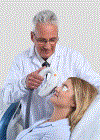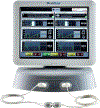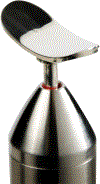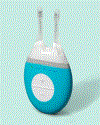Advances in dry eye disease treatment
- PMID: 30883442
- PMCID: PMC6986373
- DOI: 10.1097/ICU.0000000000000569
Advances in dry eye disease treatment
Abstract
Purpose of review: The prevalence and burden of dry eye disease continues to grow at a rapid pace, creating an increased need for new therapies. In a sector once limited to only a handful of treatments, clinicians now have multiple options available for patients who fail traditional therapies. This review summarizes the various treatment options available to clinicians treating complex dry eye disease patients.
Recent findings: As we better understand the multifactorial mechanisms leading to dry eye disease, treatments increasingly focus on the amelioration of the underlying deficiencies and inflammation, rather than on transient symptomatic relief alone. Most topical medications seek to replace deficient growth factors and/or decrease inflammation on the ocular surface. The majority of new devices and procedures seek to treat meibomian gland dysfunction, with one new device stimulating tear production through utilizing the nasolacrimal reflex pathway.
Summary: Clinicians have more options at their disposal in the treatment of dry eye disease than ever before, including topical medications and devices.
Conflict of interest statement
Conflicts of interest
MMG: Celularity (consultant); Glaxo-Smith Kline (consultant); PRN Omega (personal financial interest)
ECO, MH: None
Figures
Similar articles
-
Intense pulsed light treatment and meibomian gland expression for moderate to advanced meibomian gland dysfunction.Clin Exp Optom. 2018 Jan;101(1):23-33. doi: 10.1111/cxo.12541. Epub 2017 Jun 6. Clin Exp Optom. 2018. PMID: 28585267 Clinical Trial.
-
Update on the association between dry eye disease and meibomian gland dysfunction.Hong Kong Med J. 2019 Feb;25(1):38-47. doi: 10.12809/hkmj187331. Epub 2019 Jan 31. Hong Kong Med J. 2019. PMID: 30713149 Review.
-
Advances in procedural management of dry eye disease.Curr Opin Ophthalmol. 2025 Jul 1;36(4):308-313. doi: 10.1097/ICU.0000000000001144. Epub 2025 Apr 25. Curr Opin Ophthalmol. 2025. PMID: 40293212 Review.
-
Intense pulsed light therapy for the treatment of evaporative dry eye disease.Curr Opin Ophthalmol. 2015 Jul;26(4):314-8. doi: 10.1097/ICU.0000000000000166. Curr Opin Ophthalmol. 2015. PMID: 26058031 Review.
-
Comparison of Self-applied Heat Therapy for Meibomian Gland Dysfunction.Optom Vis Sci. 2015 Sep;92(9):e321-6. doi: 10.1097/OPX.0000000000000601. Optom Vis Sci. 2015. PMID: 25955642 Clinical Trial.
Cited by
-
Oxidative stress in the eye and its role in the pathophysiology of ocular diseases.Redox Biol. 2023 Dec;68:102967. doi: 10.1016/j.redox.2023.102967. Epub 2023 Nov 18. Redox Biol. 2023. PMID: 38006824 Free PMC article. Review.
-
Empowering vision: the impact of nursing-led educational program on patients with dry eye syndrome.BMC Nurs. 2024 Sep 27;23(1):693. doi: 10.1186/s12912-024-02318-9. BMC Nurs. 2024. PMID: 39334075 Free PMC article.
-
Performance of a Translucent Activator for LipiFlow Vectored Thermal Pulse (VTP) Treatment of Meibomian Gland Dysfunction.Clin Ophthalmol. 2022 Mar 30;16:963-971. doi: 10.2147/OPTH.S354738. eCollection 2022. Clin Ophthalmol. 2022. PMID: 35386613 Free PMC article. Clinical Trial.
-
Comparison of therapeutic effects of 0.05% Cyclosporine A versus 0.1% Fluorometholone in Chinese patients with mild dry eye unresponsive to artificial tears: a randomized control study.BMC Ophthalmol. 2024 Nov 27;24(1):513. doi: 10.1186/s12886-024-03771-5. BMC Ophthalmol. 2024. PMID: 39604906 Free PMC article. Clinical Trial.
-
Bridging the gap in managing dry eye disease: a consensus report by the Taiwan society of cataract and refractive surgeons.BMC Ophthalmol. 2024 Jul 29;24(1):314. doi: 10.1186/s12886-024-03565-9. BMC Ophthalmol. 2024. PMID: 39075430 Free PMC article.
References
-
- Farrand KF, Fridman M, Stillman IO, Schaumberg DA. Prevalence of Diagnosed Dry Eye Disease in the United States Among Adults Aged 18 Years and Older. Am J Ophthalmol 2017;182:90–98. - PubMed
-
- Pflugfelder SC. Prevalence, burden, and pharmacoeconomics of dry eye disease. Am J Manag Care. 2008;14(3 Suppl):S102–106. - PubMed
-
- Dalzell MD. Dry eye: prevalence, utilization, and economic implications. Manag Care. 2003;12(12 Suppl):9–13. - PubMed
-
- Patel VD, Watanabe JH, Strauss JA, Dubey AT. Work productivity loss in patients with dry eye disease: an online survey. Curr Med Res Opin 2011;27(5):1041–1048. - PubMed
-
- Yu J, Asche CV, Fairchild CJ. The economic burden of dry eye disease in the United States: a decision tree analysis. Cornea 2011;30(4):379–387. - PubMed
Publication types
MeSH terms
Grants and funding
LinkOut - more resources
Full Text Sources
Other Literature Sources
Medical
Research Materials






